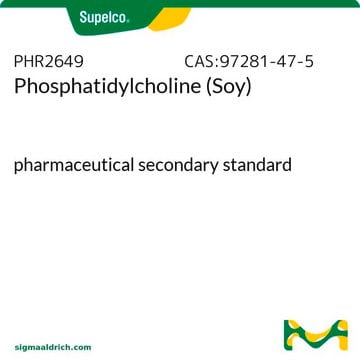SMB00611
1,2-Dilauroyl-sn-glycero-3-phosphorylglycerol sodium salt
≥98%
Synonyme(s) :
1,2-Didodecanoyl-sn-glycero-3-phosphorylglycerol sodium, 1-[[[(2,3-Dihydroxypropoxy)hydroxyphosphinyl]oxy]methyl]-1,2-ethanediyl ester-dodecanoic acid sodium
About This Item
Produits recommandés
Essai
≥98%
Forme
powder
Groupe fonctionnel
carboxylic acid
Type de lipide
phosphoglycerides
Conditions d'expédition
wet ice
Température de stockage
−20°C
InChI
1S/C30H59O10P.Na/c1-3-5-7-9-11-13-15-17-19-21-29(33)37-25-28(26-39-41(35,36)38-24-27(32)23-31)40-30(34)22-20-18-16-14-12-10-8-6-4-2;/h27-28,31-32H,3-26H2,1-2H3,(H,35,36);/q;+1/p-1/t27-,28+;/m0./s1
Clé InChI
CIRSYGHBBDDURM-DUZWKJOOSA-M
Actions biochimiques/physiologiques
Phosphatidylglycerols are used in in silico studies of model membranes. Under specific experimental conditions, they exhibit similar phase transition properties as zwitterionic phosphatidylcholines[2]. Lipid-based particle drug delivery studies using dispersions of dilauroylphosphatidylethanolamine (DLPE) and dilauroylphosphatidylglycerol (DLPG) have been shown to exhibit a metastable state which allows for the manipulation of delayed nucleation; thus providing new avenues in the design of novel modalities for the drug delivery of therapeutic payloads[3].
Code de la classe de stockage
11 - Combustible Solids
Classe de danger pour l'eau (WGK)
WGK 3
Point d'éclair (°F)
Not applicable
Point d'éclair (°C)
Not applicable
Faites votre choix parmi les versions les plus récentes :
Certificats d'analyse (COA)
Vous ne trouvez pas la bonne version ?
Si vous avez besoin d'une version particulière, vous pouvez rechercher un certificat spécifique par le numéro de lot.
Déjà en possession de ce produit ?
Retrouvez la documentation relative aux produits que vous avez récemment achetés dans la Bibliothèque de documents.
Active Filters
Notre équipe de scientifiques dispose d'une expérience dans tous les secteurs de la recherche, notamment en sciences de la vie, science des matériaux, synthèse chimique, chromatographie, analyse et dans de nombreux autres domaines..
Contacter notre Service technique








